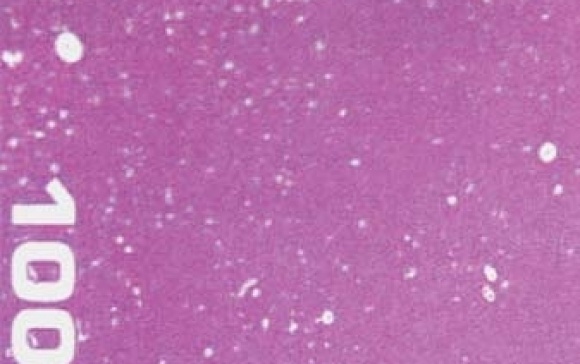Share this
Flexographic Printing Defects: Pinholing Causes and Solutions
by Luminite on Nov 11, 2019 10:29:00 AM
You may notice areas of your substrate don’t print fully, sometimes leaving tiny unprinted areas about the size of a pinhole. Quite appropriately, this common flexographic printing defect is called pinholing.
In many cases, you’re likely dealing with an ink transfer issue, which in turn could have multiple causes on its own. Among the other potential culprits, you may also have a dirty anilox or an irregular substrate surface.
Don’t fret. We’ve compiled some explanations and troubleshooting solutions for you.
Are Your Flexo Prints Pinholing? Here’s Why
The origin of your pinholing could be either mechanical or chemical.
Poor Ink Transfer
Your inks aren’t fully wetting out on the substrate. Optimal ink transfer is critical to achieving a smooth coating from your anilox roll to your image carrier to your substrate.
Depending on the type of ink (here’s a guide to 4 types and their best applications) it could be drying too quickly, ultimately failing to transfer onto the printing form. This could be a result of atmospheric conditions in your press room. Pay close attention to the following variables:
- Humidity
- Temperature
- Air circulation
Each can cause inks, particularly the water-based and alcohol-based varieties, to dry either too quickly or too slowly. Use a solvent with a slower evaporation and adjust the power of the dryers.
High Ink Viscosity
Highly viscous inks can cause problems with tackiness. Higher ink tack causes difficult image transfer to the substrate. Adjust the ink viscosity, if necessary, with additives to promote fluidity without being so thin as to become runny.
Anilox Has Lost Cell Volume or Become Dirty
Your anilox could lose cell volume due to dirty cells or wear over time. Less volume equals less space on the anilox for ink to be picked up and transferred to the image carrier. The ink then will not build up a uniform film on the substrate.
As part of routine maintenance, you should check the condition of the anilox roller and replace it, if necessary. More often, however, the anilox has become dirty with dried ink, in which case it needs a thorough cleaning with non-caustic chemicals and a non-abrasive brush.
You should also regularly clean the impression cylinder, which applies pressure to the plate/sleeve cylinder.
Substrate Has an Irregular or Damaged Surface
It’s difficult, if not impossible, to achieve full wet out on an irregular or damaged substrate surface. If your substrate is pitted or polluted, it will reject ink transfer.
As a solution, you can adjust the surface treatment of the substrate. In some cases, a material change may be a general solution.
Flexographic Printing: The Causes of Pinholing
Pinholing can be an aggravating flexographic printing defect. It could easily look like your anilox and image carrier are transferring enough ink to the substrate, but meanwhile, mechanical or chemical issues are creating an incomplete print.
Some solutions include adjusting ink viscosity, monitoring air conditions in the press room, and cleaning your anilox. Of course, there could be other variables leading to the pinholing defect. Perhaps increasing printing speed or using a softer printing form or softer mounting tape will help your cause for printing perfection.
Let’s not waste press downtime and substrate. Let’s find solutions. If you experience pinholing or any of these 11 other common flexographic printing defects, don’t hesitate to get a second opinion for troubleshooting solutions. Call (888) 545-2270.
The free guide below explains print defects in further detail.
Editor's Note: This blog post was originally published Feb 6, 2018 and was re-published November 11, 2019 to reflect updated insight.
Share this
- Flexographic Printing (81)
- Image Carrier (28)
- Elastomer sleeves (27)
- Ink Transfer (25)
- Quality (22)
- Flexo sleeve (20)
- News (18)
- printing defects (18)
- flexo printing defects (17)
- sustainability (13)
- Flexo Troubleshooting (12)
- Ink (12)
- Digital Printing (10)
- Flexo 101 (10)
- Flexo Inks, (9)
- Anilox (7)
- Blister Packaging (7)
- Cost (6)
- print misregistration (6)
- regulations (6)
- Corrugated Printing (4)
- pinholing (4)
- "Tradeshow (3)
- Digital Flexo (3)
- Gravure Printing (3)
- Insider (3)
- Load-N-Lok (3)
- Wide Web (3)
- direct laser engraving (3)
- flexo-equipment-accessories (3)
- gear marks (3)
- halo (3)
- testing (3)
- Narrow Web (2)
- bridging (2)
- feathering (2)
- filling in (2)
- mottled image (2)
- pressure (2)
- Labelexpo (1)
- dirty prints (1)
- doughnuts (1)
- embossing (1)
- kiss impression (1)
- October 2023 (2)
- September 2023 (1)
- August 2023 (1)
- July 2023 (3)
- June 2023 (1)
- May 2023 (5)
- April 2023 (1)
- March 2023 (2)
- February 2023 (1)
- January 2023 (3)
- December 2022 (1)
- October 2022 (3)
- September 2022 (2)
- August 2022 (2)
- July 2022 (3)
- May 2022 (1)
- April 2022 (4)
- March 2022 (2)
- February 2022 (5)
- January 2022 (7)
- December 2021 (1)
- November 2021 (3)
- October 2021 (2)
- September 2021 (1)
- August 2021 (1)
- July 2021 (3)
- June 2021 (1)
- May 2021 (4)
- April 2021 (4)
- March 2021 (4)
- February 2021 (2)
- December 2020 (1)
- November 2020 (1)
- October 2020 (2)
- September 2020 (1)
- August 2020 (3)
- July 2020 (2)
- June 2020 (3)
- May 2020 (1)
- April 2020 (1)
- November 2019 (3)
- October 2019 (1)
- August 2019 (1)
- July 2019 (1)
- April 2019 (1)
- March 2019 (1)
- January 2019 (1)
- October 2018 (2)
- August 2018 (1)
- July 2018 (1)
- June 2018 (1)
- February 2018 (2)
- October 2017 (1)
- September 2017 (2)
- January 2016 (1)
- February 2015 (1)
- January 2015 (1)
- December 2014 (2)
- September 2014 (1)
- February 2014 (1)
- January 2014 (1)
- December 2013 (3)
- October 2013 (1)
- September 2013 (1)
- June 2013 (1)
- January 2013 (1)




Comments (6)